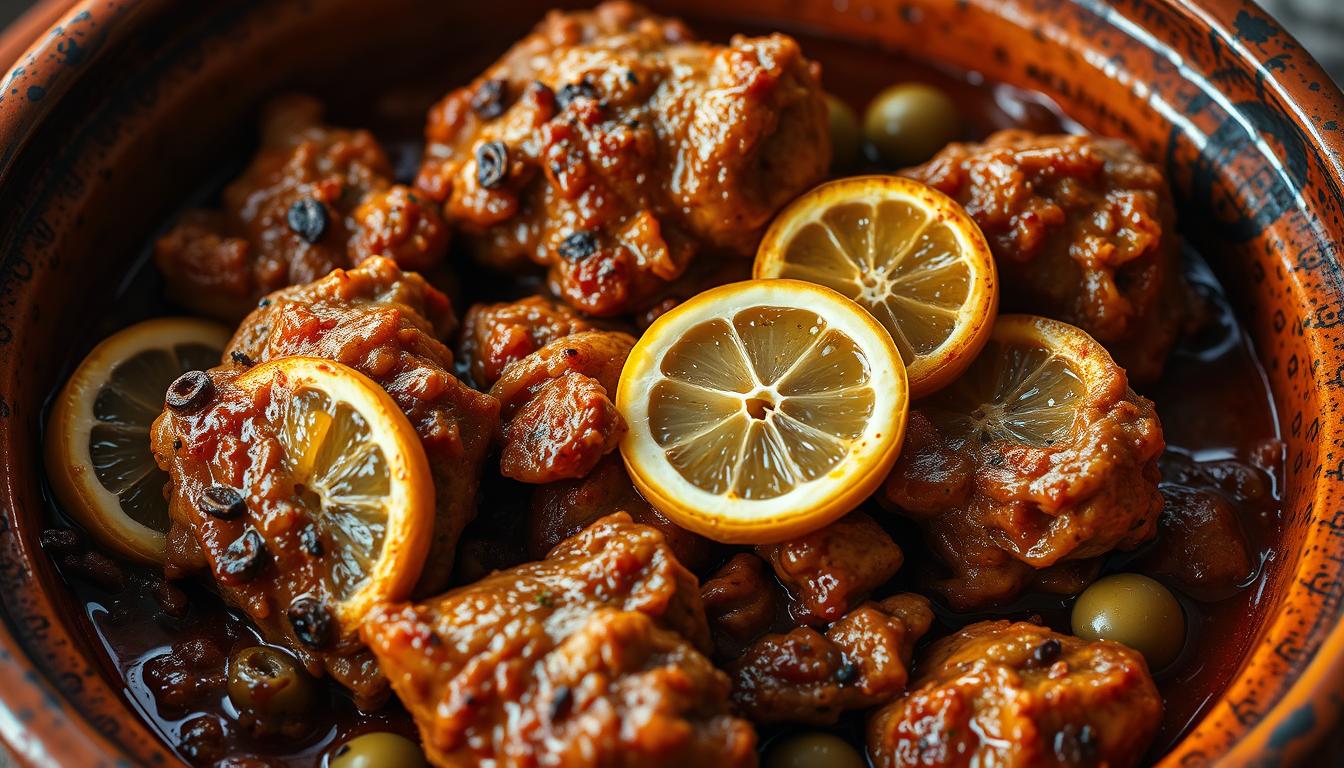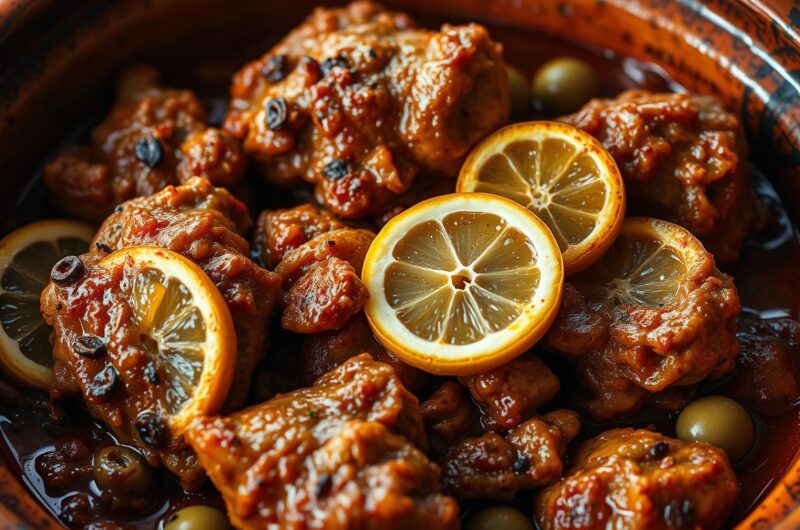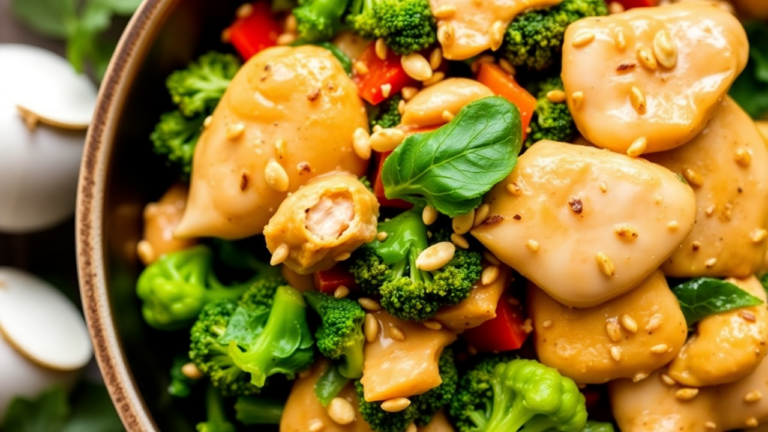Chicken Tagine with Preserved Lemon and Olives – A Traditional Moroccan Delight
Chicken Tagine with Preserved Lemon and Olives is a timeless dish from Morocco. It combines earthy spices like cumin and ginger with the zesty taste of preserved lemons and the salty olives. Each bite brings to life the stories of North African kitchens, where tajin recipes are cherished for generations.
This dish may seem rooted in tradition, but it’s easy for anyone to make at home. You just need common ingredients and a clay pot or Dutch oven. The result is a dish that perfectly balances tangy, savory, and sweet flavors, just like authentic tajin cooking.
Chicken Tagine with Preserved Lemon and Olives – A Traditional Moroccan Delight
Course: Breakfast4–6
servings20
minutes1
hour400–500
kcalIngredients
Main Ingredients:
1.5 kg (3 lbs) bone-in chicken thighs or drumsticks
2 preserved lemons, rinsed and quartered
1 cup green Moroccan olives or Kalamata olives
2 medium onions, finely chopped
3 cloves garlic, minced
2 tbsp olive oil
1 cup chicken broth or waterSpice Mix:
1 tsp ground cumin
1 tsp ground ginger
1 tsp paprika
½ tsp ground cinnamon
½ tsp ground turmeric
¼ tsp saffron threads (optional, soaked in warm water)
Salt and black pepper, to tasteFor Garnish & Serving:
Fresh cilantro or parsley, chopped
Harissa (optional, for extra heat)
Steamed couscous or crusty bread
Directions
- Prepare the Chicken and Marinade
In a large bowl, mix the spice blend (cumin, ginger, paprika, cinnamon, turmeric, saffron, salt, and black pepper).
Add olive oil, minced garlic, and lemon juice (from ½ a preserved lemon) to the spice mix.
Coat the chicken pieces well with the marinade. Cover and let it marinate for at least 2–4 hours (preferably overnight) in the refrigerator. - Sauté the Aromatics
Heat olive oil in a tajine pot or Dutch oven over medium heat.
Add the chopped onions and sauté until soft and golden, about 5 minutes. - Slow Cooking the Tagine
Arrange the marinated chicken over the onions in the pot. Pour in the chicken broth.
Cover the tajine and cook on low heat for 45–60 minutes, without opening the lid too often. - Add Preserved Lemons and Olives
After 45 minutes, add the quartered preserved lemons and olives to the pot.
Let the tajine cook uncovered for 10–15 more minutes, allowing the sauce to thicken slightly. - Garnish and Serve
Remove from heat and let it rest for 5 minutes. Garnish with fresh cilantro or parsley.
Serve hot with steamed couscous, warm bread, or rice.
Chicken Tagine Key Takeaways
- A tajine pot is essential for capturing the slow-cooked essence of traditional Moroccan tajin recipes.
- Preserved lemons and olives add signature tajin flavors, contrasting with tender chicken and warm spices.
- North African spices like ras el hanout elevate the dish without requiring exotic ingredients.
- Weeknight-friendly adaptations retain the soul of classic tajin cooking while fitting modern schedules.
- Pairing with couscous or bread showcases the dish as a centerpiece in both Moroccan and American kitchens.
Understanding the Authentic Tajin: Morocco’s Famous Clay Pot Dish
The tajine is at the heart of Moroccan cooking. It’s not just a pot, but a tradition. This part will dive into its history, clear up confusion, and talk about its health benefits.
The History and Cultural Significance of Tajin in North African Cuisine
Tajines have been more than just pots for centuries. They symbolize community. The cone-shaped clay pot traps steam, cooking food slowly to make it tender.
Families come together around tajines during festivals and meals. They share stories while the food cooks. This method keeps nutrients in the food, a key benefit of tajin loved for generations.
Tajin vs. Tajín: Clearing Up the Confusion with Mexican Seasoning
Don’t mix up Moroccan tajines with tajin mexican seasoning. Here’s why:
- Moroccan Tajine: A clay pot and dish using spices like cumin and ginger.
- Tajín Seasoning: A Mexican citrus-salt blend, often used on fruit. They share a name but no culinary ties.
Health Benefits of Traditional Moroccan Tajin Cooking
Slow cooking in a tajine keeps nutrients in the food. Olive oil, a key ingredient, is good for the heart. Spices like turmeric and ginger have anti-inflammatory properties.
Plus, preserved lemons in many recipes add probiotics. These tajin benefits make every bite both comforting and healthy.
Essential Ingredients and Equipment for Perfect Chicken Tajin
Mastering tajine poulet begins with the right ingredients and tools. Use bone-in chicken thighs for juicy results. Dark meat stays moist during slow cooking.
For the tajin spice blend, mix cumin, paprika, ginger, and saffron. A simple tajin seasoning recipes online can help. But, fresh spices from stores like Penzey’s or McCormick are best.
- Spice Mix: Grind whole spices for deeper flavor.
- Preserved lemons: Look for brands like Moroccan Market Co. in Middle Eastern groceries.
- Equipment: A traditional clay tajin pot ensures even heat, but a Dutch oven works as a substitute.
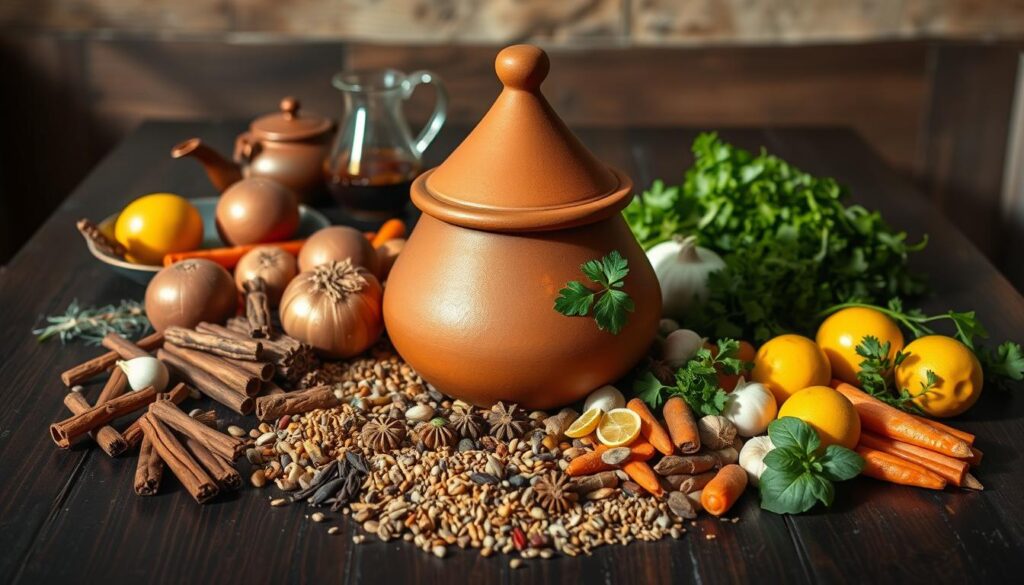
When shopping for a tajin pot, check specialty stores like Kalustyan’s. You can also order online from brands like TagineShop on Amazon. Always hand-wash clay pots to keep them porous.
For tajin seasoning recipes, mix 1 tbsp cumin, 2 tsp paprika, ½ tsp ginger, and a pinch of saffron. If you can’t find preserved lemons, pickled ones are a good substitute. They add a unique tang.
Plan ahead: marinate chicken in spices overnight for richer flavor. Serve with couscous or crusty bread. Happy cooking!
Step-by-Step Guide to Creating Your Chicken Tajin with Preserved Lemon and Olives
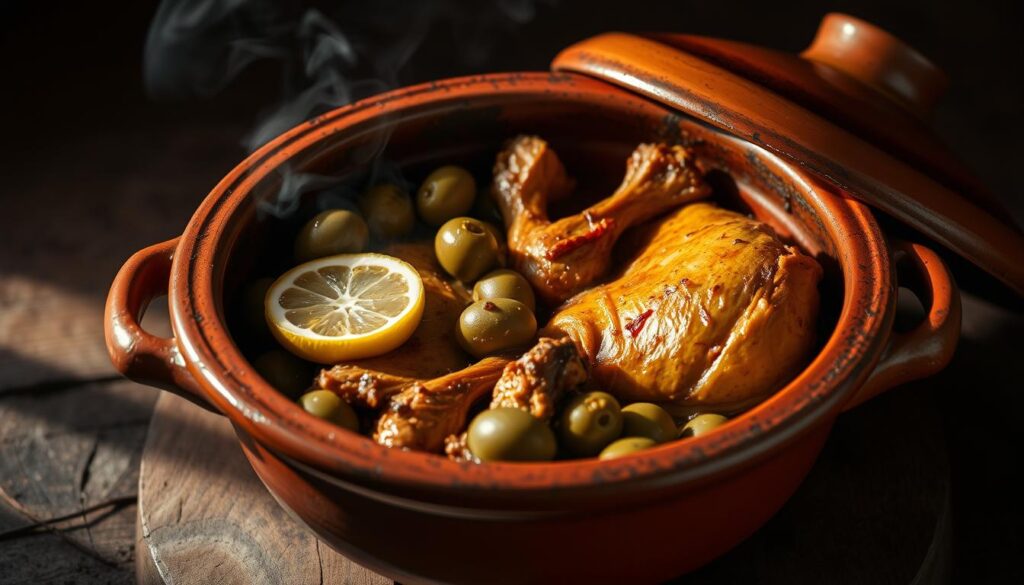
Learn to make tajine poulet citron confit with this simple guide. Choose bone-in chicken thighs for the best flavor. Remove excess fat and season both sides with tajin spice like cumin, paprika, and cinnamon.
Marinate the chicken in olive oil, lemon juice, and your favorite tajin seasoning recipes for 2–4 hours.
Preparing the Chicken and Marinade
- Cut garlic and ginger into a paste using a microplane.
- Combine with marinated chicken in a bowl, ensuring even coating.
- Refrigerate while prepping other ingredients to deepen flavor.
Working with Preserved Lemons and Moroccan Olives
Rinse preserved lemons to remove excess salt. Gently slice them, discarding seeds and very bitter rinds. Use kalamata or green Moroccan olives—add both to the pot during the last 20 minutes of cooking. Their briny tang balances the chicken’s richness.
Slow-Cooking Techniques for Maximum Flavor
Layer marinated chicken, onions, and spices in a clay tagine or Dutch oven. Add broth, cover tightly, and simmer on low heat for 45–60 minutes. The tajin recipes success relies on steady, gentle heat—avoid lifting the lid until done. Check doneness when meat pulls easily from bones.
Serving Suggestions and Traditional Accompaniments
Serve over steamed couscous or with crusty bread to soak up juices. Garnish with fresh cilantro and a drizzle of harissa for heat. Pair with a side of roasted carrots or a zesty orange salad for balance.
Conclusion: Bringing Moroccan Flavors to Your American Kitchen
Exploring tajine cooking opens a door to Morocco’s rich culinary heritage. Your chicken tajine with preserved lemon and olives is more than a meal. It’s a celebration of flavors shaped by centuries of tradition.
The slow-cooked tajin method ensures tender meat and bold flavors. These flavors blend spices like cumin and paprika with tangy preserved lemons. This dish is perfect for American tables, whether served with couscous or crusty bread.
Embracing tajin benefits means enjoying health advantages and convenience. The slow simmer locks in nutrients while creating deep, complex tastes. Don’t worry if your first attempt feels imperfect; Moroccan cuisine thrives on patience.
Let leftovers rest overnight—the flavors meld even more, turning a good meal into an unforgettable one. For adventurous cooks, try swapping chicken for lamb or adding prunes for a sweet-savory twist, always staying true to the tajine’s roots.
Sharing this dish with loved ones captures the spirit of Moroccan dining. Imagine your kitchen filled with the aroma of saffron and cinnamon, just like bustling markets in Marrakech. Whether you’re hosting a dinner party or a casual weeknight meal, a well-prepared tajine invites conversation and connection.
Remember, the heart of any tajine lies in balancing spices and respecting its heritage while making it your own.
Now that you’ve mastered this recipe, explore other tajin flavors—try vegetable tajine or fish variations. With a little practice, you’ll unlock a world of dishes that honor tradition while fitting seamlessly into modern American cooking. Your kitchen is ready to become a gateway to North Africa, one flavorful bite at a time.
FAQ
What is a tajin and how is it used in cooking?
A tajin, also known as a tagine, is a clay cooking vessel from Morocco. It has a conical lid. This design helps cook food slowly, keeping it moist and flavorful.
Can I use a tajin to make other dishes besides Moroccan meals?
Absolutely! Tajin is great for more than just Moroccan dishes. You can try it with roasted veggies or stews from other cultures.
What ingredients are essential for a classic chicken tajin?
For a classic chicken tajin, you need bone-in chicken, preserved lemons, and Moroccan olives. Spices like cumin and coriander, along with garlic and onions, add to the flavor.
How can I make my own tajin spice blend for seasoning?
To make your own tajin spice blend, mix ground cumin, coriander, ginger, and cinnamon. Add paprika, salt, and pepper to taste. This way, you can adjust the flavors to your liking.
Is there a substitute for preserved lemons in a tajin recipe?
If you can’t find preserved lemons, use lemon juice, salt, and lemon zest. This mix captures the tartness and flavor needed in tajin recipes.
Where can I buy an authentic tajin pot in the United States?
You can find authentic tajin pots at specialty kitchen stores, Middle Eastern markets, or online. Amazon and cookware websites are good places to start.
What are the health benefits of cooking with tajin?
Cooking with a tajin uses slow-cooking methods that keep nutrients in food. Tajin recipes often include olive oil, herbs, and spices. These are good for your heart and make meals nutritious.
Can I use a slow cooker instead of a tajin pot?
Yes, a slow cooker is a good substitute for a tajin pot. While the results might be slightly different, a slow cooker can still make delicious tajin-style dishes.
Are there any Mexican flavor profiles similar to Moroccan tajin?
While Moroccan tajin and Mexican Tajín seasoning are different, you can mix spices like cumin, chili, lime, and salt. This blend captures the vibrant flavors of both cuisines.
